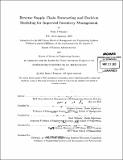Reverse supply chain forecasting and decision modeling for improved inventory management
Author(s)
Petersen, Brian J. (Brian Jude)
DownloadFull printable version (7.476Mb)
Other Contributors
Leaders for Global Operations Program.
Advisor
Stephen Graves and Mort Webster.
Terms of use
Metadata
Show full item recordAbstract
This thesis details research performed during a six-month engagement with Verizon Wireless (VzW) in the latter half of 2012. The key outcomes are a forecasting model and decision-support framework to improve management of VzW's reverse supply chain inventory. The forecasting model relies on a reliability engineering formulation and incorporates a learning component to allow incremental forecast improvement throughout the device lifecycle. The decision-support model relies on Monte Carlo simulations to quantify the uncertainty and risk associated with different inventory management policies. These tools provide VzW stakeholders with a full-lifecycle perspective so that inventory planners can avoid costly end-of-life underages and overages. Prior to this effort, inventory planners at VzW relied on a three month returns forecast despite the fact that customers can return devices more than three years after launch. The decision-support model replaces existing heuristics to improve inventory management. Model efficacy is demonstrated through case studies. For a variety of representative SKUs, the returns forecast model is found to predict cumulative lifecycle returns within 10% using data available six months from launch. Had inventory been managed according to the policies recommended by the decision support model instead of policies from existing heuristics, VzW could have avoided an end-of-life stockout of more than 20,000 devices for a particular SKU.
Description
Thesis (S.M.)--Massachusetts Institute of Technology, Engineering Systems Division; and, (M.B.A.)--Massachusetts Institute of Technology, Sloan School of Management; in conjunction with the Leaders for Global Operations Program at MIT, 2013. Cataloged from PDF version of thesis. Includes bibliographical references (p. 69-71).
Date issued
2013Department
Leaders for Global Operations Program at MIT; Massachusetts Institute of Technology. Engineering Systems Division; Sloan School of ManagementPublisher
Massachusetts Institute of Technology
Keywords
Engineering Systems Division., Sloan School of Management., Leaders for Global Operations Program.